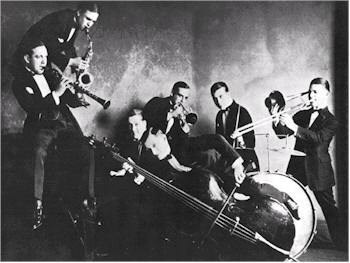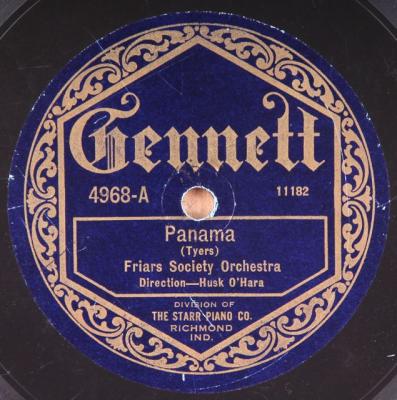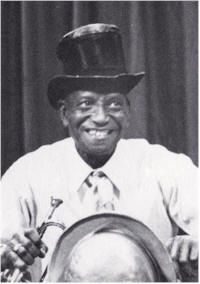
New Orleans Rhythm Kings. Photo courtesy redhotjazz.
Before World War I, at a time when jazz was still defining itself, musicians in New Orleans began to swing popular Tin Pan Alley numbers like “Let Me Call You Sweetheart” and “Panama” at latenight jam sessions after their regular gigs. They learned these numbers from sheet music and played them ‘straight’ at society dances and picnics in the parks. Some were traditional waltzes, marches and schottisches but others were newer, syncopated dance pieces— cakewalks, two-steps and fox trots.
“Panama,” composed in 1911 by William H. Tyers remains a standard in the repertoire of New Orleans-style jazz bands. The tune is a classic New Orleans march with four different ‘strains’ or melodies. Each melody is first played and then followed by improvisation. “Panama” was widely recorded at the height of the Jazz Age by such diverse groups as Red Nichols and his Five Pennies, and bands led by Jelly Roll Morton and Kid Ory.

The 1922 NORK recording of "Panama" was released under the name the Friars Society Orchestra. Image courtesy Starr Gennett Foundation.
But it was the New Orleans Rhythm Kings’ 1922 Gennett recording of “Panama” that had the greatest influence on the younger generation, especially a group of jazz-crazed high school kids in Chicago who came to be known as the Austin High Gang. The sound of the NORK ensemble and trumpeter Paul Mares' King Oliver-inspired wa-wa mute places the band squarely in the traditional New Orleans dance orchestra style of the early 1920s.
New Orleans Rhythm King pianist Elmer Schoebel composed a number of hot jazz pieces including “I Never Knew What a Gal Could Do.” Traditional lore associated with the tune offers a tongue-in-cheek alternate title — "Zero."
This week on Riverwalk Jazz, The Jim Cullum Jazz Band and visiting star clarinetist Evan Christopher from New Orleans continue the long tradition of late night jam sessions playing these numbers and a wide ranging selection of tunes that have been favorites of players who love the hot style of jazz.
Also on the agenda is “Big Butter and Egg Man” from the 1920s' Hot Five and Hot Seven collaboration between Louis Armstrong and Percy Venable. Venable was the producer of Armstrong’s floor shows at the Sunset Café on the South Side of Chicago. The "Big Butter and Egg Man" of the title is the more wholesome, southern rural equivalent of a ‘sugar daddy.’
Trumpeter 'Kid' Thomas Valentine wrote “Algiers Strut” in 1946. The title commemorates Algiers, Louisiana, the suburb of New Orleans where he formed his band in the 1920s and played for decades. Valentine played an old style of traditional jazz—hot, bluesy and with a heavy beat. A key figure of the classic Jazz Revival movement of the 1940s, he was a regular on the bandstand at Preservation Hall from the 1960s to the 1980s. Valentine, who was equal parts showman and musician, had the fitting motto "Let joy be unrefined."
“All Night Blues,” the title track of this week’s broadcast, was composed by Richard M. Jones and Clarence Williams in 1923. The renowned blues singer Clara Smith made a classic recording of it that year. In the high point of her career Smith was considered second only to Bessie Smith (no relation) and was billed as the "Queen of the Moaners" on the TOBA vaudeville circuit.
There were many recorded versions of "Do You Ever Think of Me." When The Jim Cullum Jazz Band plays this tune, uppermost in their minds is the driving feel of the version that Bob Crosby and his Bob Cats recorded in 1940. The Bob Cats were a group of great jazz talents who revived the sound and feel of classic, traditional New Orleans jazz.
Blues, hot jazz, pop tunes and Swing create the many moods of a classic jam session with The Jim Cullum Jazz Band at The Landing in San Antonio.
Photo credit for Home Page: New Orleans Rhythm Kings. Photo courtesy redhotjazz.
Text based on Riverwalk Jazz script by Margaret Moos Pick ©2005


